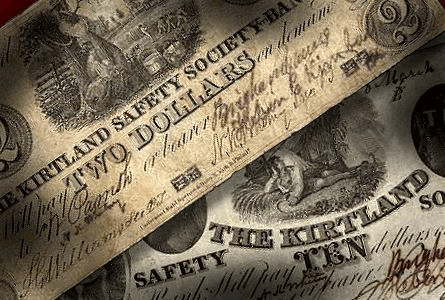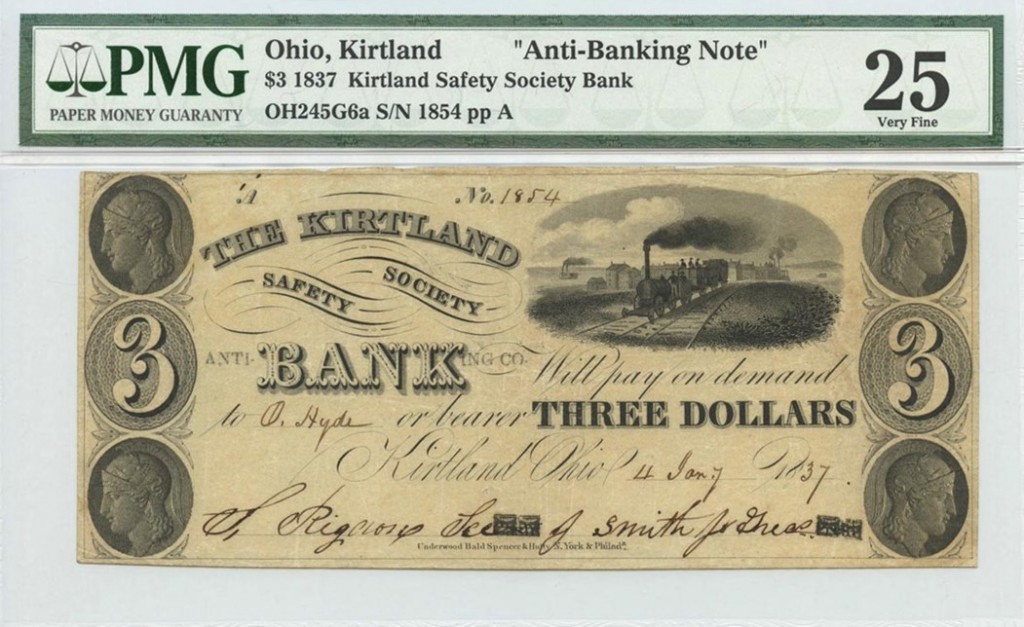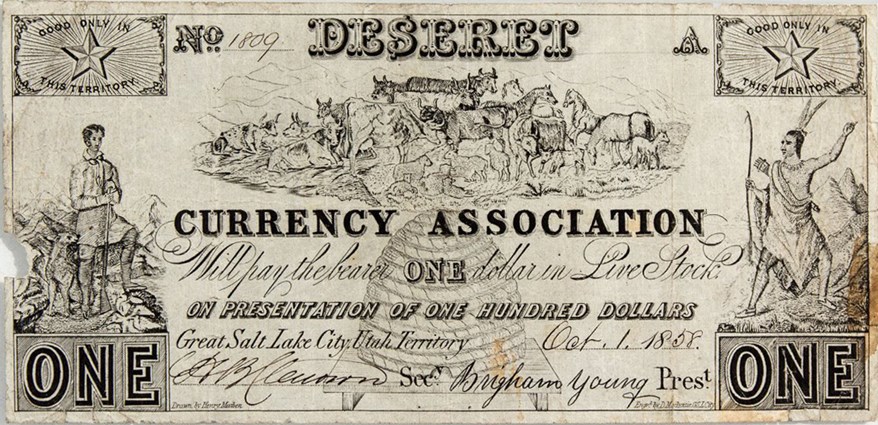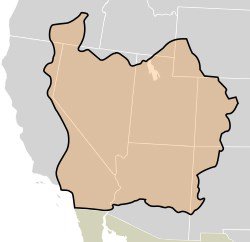Banknotes provide a snapshot of the history of Mormons and their trek across the United States
By Zachary Habermas – Paper Money Guaranty …..
 Within the banknote collecting universe, there is a group of notes that garners a relatively large amount of interest. Currency printed by followers of the Church of Jesus Christ of Latter Day Saints (LDS), or Mormons, gives a snapshot into the tumultuous years after the founding of the LDS Church. They reveal the oppression many of the followers faced and the innovation they showed in trying to expand throughout the United States. Today, some of this currency is quite rare and can fetch a decent price at auction. The following are some examples of the different types of currency printed by Mormons throughout their history.
Within the banknote collecting universe, there is a group of notes that garners a relatively large amount of interest. Currency printed by followers of the Church of Jesus Christ of Latter Day Saints (LDS), or Mormons, gives a snapshot into the tumultuous years after the founding of the LDS Church. They reveal the oppression many of the followers faced and the innovation they showed in trying to expand throughout the United States. Today, some of this currency is quite rare and can fetch a decent price at auction. The following are some examples of the different types of currency printed by Mormons throughout their history.
Kirtland Safety Society Anti-Banking Co.
The issuance of Mormon currency began shortly after the founding of the Church of Jesus Christ of Latter Day Saints in 1830.
In 1836 many Mormons had resettled to Kirtland, Ohio from the east coast. There they had decided to start a bank. This was a time when hundreds of banks, both legitimate and not, had sprung up. The number of banks increased with the demand for credit throughout the United States. After gathering the plates and printing a significant sum of banknotes the Kirtland Safety Society Bank applied for a charter from the state of Ohio. However, Ohio denied their charter due to lack of capital.

This did not stop the Mormons as they came up with an interesting plan. They eventually modified the notes by changing the bank title to “Kirtland Safety Society Anti-Banking Co.” as well as blocking out the titles “Cashier” and “President” and replacing them with “Secretary” and “Treasurer.” This was an attempt to differentiate the institution from a bank as it had no legal charter to operate.
Only a small amount of notes were changed and it was only done to the $1, $2 and $3 banknotes, not the higher denominations. Some of these notes were signed by Joseph Smith Jr., the founder of Mormonism and the LDS movement. However, many of these were done by scribes and it is impossible to determine which notes carry a genuine signature. The notes were virtually worthless outside of Kirtland and were often traded at 12.5 cents on the dollar. Eventually the bank collapsed and many of the Mormon inhabitants left the city. Today, the rarest form of these notes is one that has been modified and countersigned. An example of this can be seen above.

The State of Deseret
In 1849 many Mormons had resettled in the mostly ungoverned west. There they established the State of Deseret. Brigham Young, the president of the LDS Church at the time, was to be governor of this territory. The plan was to get recognized as a territory or state by the U.S. government. However, this never happened and the council governing the area was disbanded after the U.S. created the State of California and Territories of Utah and New Mexico.
Young was eventually installed as the first governor of the Territory of Utah.
During its short history, the State of Deseret managed to create a functioning government that appointed judges and created a criminal code. They even had their own militia modeled after the Nauvoo militia from Nauvoo, Illinois, another important Mormon settlement.
In addition to this, currency was issued by the Deseret Currency Association. Since there was very little gold or silver to back up the currency, the currency was backed by livestock. The currency was used to pay workers at the church and came in denominations of $1, $2, $3, $5, $10, $20, $50 and $100. There are few surviving examples of the $1-$5 denominations, and no genuine examples of the higher values have been found. The notes are scarce and can be worth a decent amount even in circulated grades.

Mark Hofmann Forgeries
Due to the high value of the Mormon notes, it is understandable that people would create forgeries of them for personal gain. As they are not legal tender, there is no law being broken in making counterfeits of these notes.
The best of these forgeries were done by a man named Mark Hofmann.
Hofmann would use paper from books that were over 150 years old, thus matching the type of paper used for the Mormon notes. He also obtained an official embossing seal that was used on many notes. This made his forgeries quite deceptive, fooling many experts. Hofmann went on to forge many other historical documents related to Mormonism throughout his life before he was arrested for murder.
There are many other examples of Mormon currency stretching across the United States. They exist mostly as scrip notes, coming from private merchants. The countless varieties show how the Mormon community tried many different ways at prospering, despite often being around a hostile populace. The banknotes provide a snapshot of the history of Mormons and their trek across the U.S.
Be on the lookout for Mormon currency to add to your collection and always be careful not to get fooled by any Hofmann forgeries.
Sources
Nyholm, Douglas A. (2010). Mormon Currency 1837-1937.
Originally posted on www.pmgnotes.com.
PMG is an independent member of the Certified Collectibles Group (CCG).




